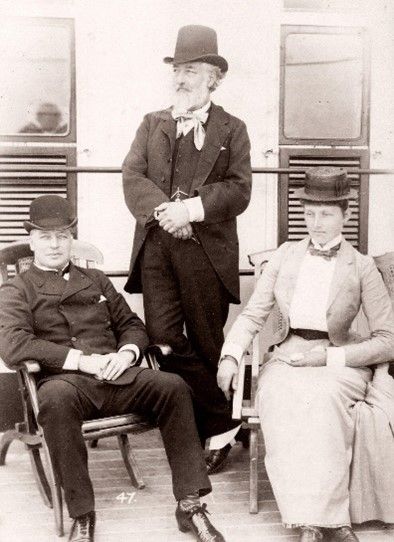Treasures and Travels: Leighton and Landscape art
)
Image credit for above: Frederic Leighton’s artist studio. ©The Royal Borough of Kensington and Chelsea. Image Dirk Lindner
Frederic, Lord Leighton (1830-1896) is recognised as one of the most prominent figures of 19th century British art. Travel was an important part of Leighton’s life from childhood. By his late teens, he was living with his family in Frankfurt, Germany and had already visited many of Europe’s major cities, including Florence and Rome; places which he would return to on many occasions over the next decades.
Once settled in London to pursue an artistic career, he continued to make extensive trips on an annual basis until shortly before his death. The countries that Leighton visited on at least one occasion include Austria, Algeria, Egypt, France, Germany, Greece, Ireland, Italy, Lebanon, Morocco, The Netherlands, Scotland, Spain, Switzerland, Syria and Turkey.

Frederic Leighton (centre) on board RMS Teutonic, 1889. ©The Royal Borough of Kensington and Chelsea.
Fascination with the Islamic world.
Leighton’s journeys to North Africa and the Middle East were part of a trend in the nineteenth century to travel to these regions. Artists found plentiful subjects for their paintings which satisfied a growing demand for depictions of the ‘exotic Orient’.
Leighton’s visit to Algeria in 1857 probably first inspired him to start collecting artefacts from the Islamic world. During the 1860s and early 1870s he amassed the bulk of his collection – ranging from traditional tiles, ceramics, textiles, metalwork and woodwork – which was intended to decorate the aesthetic interiors of his artist-house in Kensington. Further trips to Turkey, Egypt and Syria, inspired the creation of the extraordinary Arab Hall, ‘a little addition for the sake of something beautiful to look at once in a while’

The Arab Hall at Leighon House. ©The Royal Borough of Kensington and Chelsea. Image Dirk Lindner.
Seascapes: Andalusian coast and ‘the island of his heart’
While in the continent, trips to Italy and Spain were frequent, with Leighton’s favouring seaside cities in the Andalusian region and the iconic mediterranean island of Capri.
His painting Bay of Cádiz, Moonlight (1866), recently rediscovered and acquired by Leighton House, captured the vibrancy of the Spanish nights in just a few brushstrokes, perhaps in an attempt to emulate the Impressionists technique.
Capri, ‘the island of his heart’, is the subject of a vast array of oil studies that Leighton produced during his multiple trips in 1859, 1871 and 1875, documenting the traditional architecture and famous landmarks as well as more unusual locations and intriguing views.

Frederic Leighton, Bay of Cádiz, Moonlight, (1866) © The Royal Borough of Kensington and Chelsea. Image Jaron James.
Leighton and Landscape
Partly, Leighton’s escapes were to produce small landscape sketches in oils as he travelled. Primarily painted for his own enjoyment and relaxation, these works were only rarely exhibited and lined the walls of his studio in London.
The upcoming exhibition at Leighton House, Leighton and Landscape. Impressions from Nature (16 November 2024 – 27 April 2025) will showcase many of these paintings for the first time and will reveal the celebrated Victorian artist in a new light - that of a spontaneous, experimental artist who took the road less well trodden by his contemporaries
Leighton’s landscape sketches connect his art, his travels throughout Europe, South West Asia and North Africa, and his studio-home, bringing together much of what makes Leighton such a fascinating figure.

Frederic Leighton, View of Maqam al-Arba’in, Mount Qasioun, Damascus © The Royal Borough of Kensington and Chelsea.


